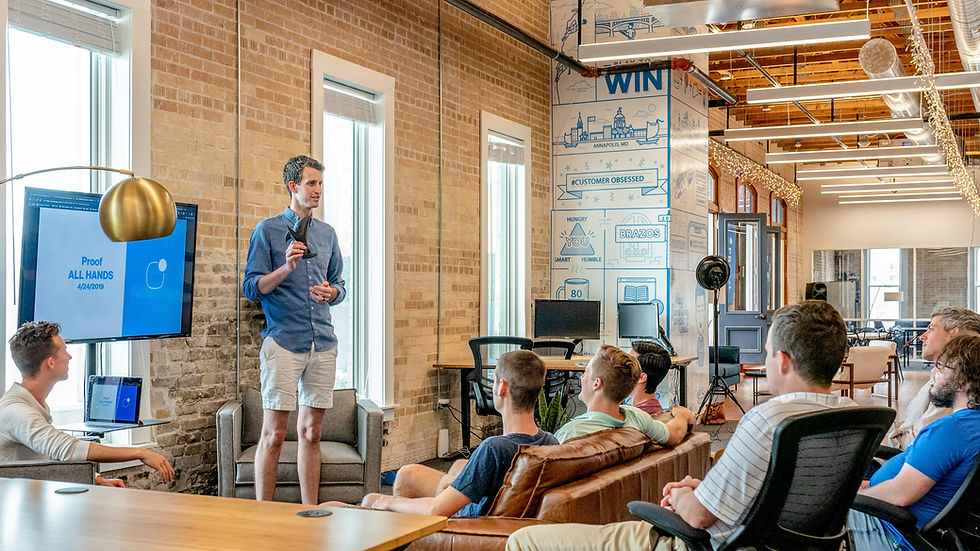How to Build a Digital-First Culture
- Apr 28
- 4 min read
Technology can transform businesses, but without a supportive culture, even the best digital initiatives struggle. For leadership teams of scaling businesses, building a "digital-first" culture is essential to turning strategic ambitions into lasting success. It's not just about adopting new technologies; it's about fostering an organizational mindset that values innovation, agility, and continuous learning. To drive transformation, leadership teams must take the lead in building a digital-first environment that empowers employees, aligns with business goals, and accelerates growth. This guide shows how leadership can foster a culture that embraces technology, innovation, and continuous improvement.

Setting the Tone for Digital Transformation
The foundation of a digital culture starts with leadership. As a leader, your mindset shapes the future of your organization’s digital journey. Leaders who prioritize digital transformation must demonstrate commitment by:
Championing Change: Embrace the digital shift as a fundamental change rather than a temporary trend. By leading from the front, you show your team that digital transformation is not optional but a strategic imperative for the future.
Being Adaptable: The pace of digital innovation requires a flexible mindset. Leaders must be open to new ideas, be comfortable with experimentation, and be willing to pivot when necessary.
Leading with Vision: Articulate a clear vision of what digital transformation means for the organization. Help employees understand the bigger picture—how technology impacts not only their work but also the company’s ability to compete and thrive in the market.
By establishing these leadership principles, you foster an environment where employees feel encouraged to embrace digital tools and strategies, knowing that leadership supports and guides their efforts.
Upskilling Teams for the Digital Future
A successful digital culture requires continuous learning and development. However, it’s not enough to simply introduce new technologies, employees need the knowledge and skills to use them effectively. Training plays a pivotal role in ensuring your workforce is equipped for the digital age.
Key Training Strategies:
Comprehensive Onboarding for New Tools: When introducing new software or technologies, provide structured onboarding sessions that explain not only the functionality but also how the tool fits into the organization’s overall digital strategy.
Ongoing Learning Programs: Implement regular training sessions or workshops focused on emerging technologies, digital trends and soft skills like problem-solving and adaptability. Encourage employees to take ownership of their learning by offering access to online courses, certifications and resources.
Encourage Cross-Department Collaboration: Digital transformation affects every aspect of the business, so it’s important to create opportunities for teams to collaborate. Hold workshops or cross-functional meetings to discuss how different departments can leverage digital tools to achieve shared goals.
Communication Strategies: Fostering Transparency and Engagement
Effective communication is at the heart of building a successful digital culture. Leaders must prioritize transparency, making sure everyone in the organization understands the "why" behind the digital initiatives. Clear, consistent messaging ensures that employees are aligned with the organization’s vision and can confidently participate in the transformation process.
Effective Communication Tactics:
Frequent Updates from Leadership: Regular communication from leadership—whether through town hall meetings, newsletters, or internal platforms, reinforces the organization’s digital vision. Use these opportunities to share progress, successes, challenges, and future goals.
Open Channels for Feedback: Encourage employees to voice their thoughts, concerns, and ideas about the digital transformation journey. This feedback loop not only empowers employees but also helps leaders refine strategies for improvement.
Celebrate Digital Wins: Recognize and celebrate milestones and successes, both big and small, within the digital transformation process. Publicly acknowledge teams or individuals who have made strides in adopting new technologies or contributing innovative solutions.
Recognizing and Reinforcing Digital Excellence
Building a digital culture also requires reinforcing positive behaviors through rewards and recognition. Acknowledge those who embrace digital tools, exhibit creativity, or contribute to successful digital projects. This reinforces the message that digital initiatives are critical to the company’s success and rewards the employees who make it happen.
Reward Strategies:
Incentivize Digital Achievements: Implement a reward system that ties incentives (such as bonuses, promotions, or recognition) to the successful adoption of digital tools or significant contributions to digital projects. This motivates employees to adopt a digital-first mindset.
Highlight Digital Champions: Nominate employees who champion the digital transformation efforts as “Digital Ambassadors” or “Change Champions.” These individuals can serve as role models for others, helping to drive adoption and mentor colleagues through the transition.
Gamify Digital Engagement: Introduce gamification elements to encourage employees to engage with digital tools and platforms. Create challenges, leaderboards, or badges for completing certain tasks or mastering new technologies.
Building a strong digital culture goes hand-in-hand with managing change effectively, explore why Change Management is critical to successful digital transformation.
Building a Sustainable Digital Culture
Ultimately, building a digital culture isn’t about a single initiative or a one-time project; it’s about creating an environment where digital transformation is a continuous, evolving process. It requires a mindset shift, consistent training, transparent communication and a system of rewards and recognition. As a leader, you play a crucial role in setting the tone and guiding your organization through the digital journey.
When done right, a digital culture not only boosts productivity and innovation but also prepares your business for long-term success in a competitive, ever-changing market. Start today by aligning your leadership mindset with a strategic, people-centered approach to digital transformation and watch your organization thrive.
Now that you've established the foundation for a digital culture, the next step is to prioritize the right technology projects to maximize impact, learn how to strategically focus your efforts in our next article on prioritizing technology projects for growth.
Ready to empower your teams and future-proof your organization? Explore our Factional Leadership Services and Technology Strategy Consulting services, or contact us today for a personalized consultation.




Comments